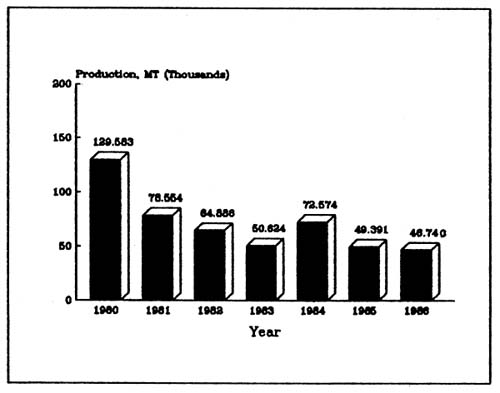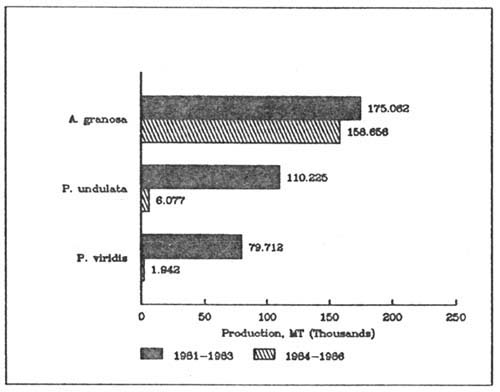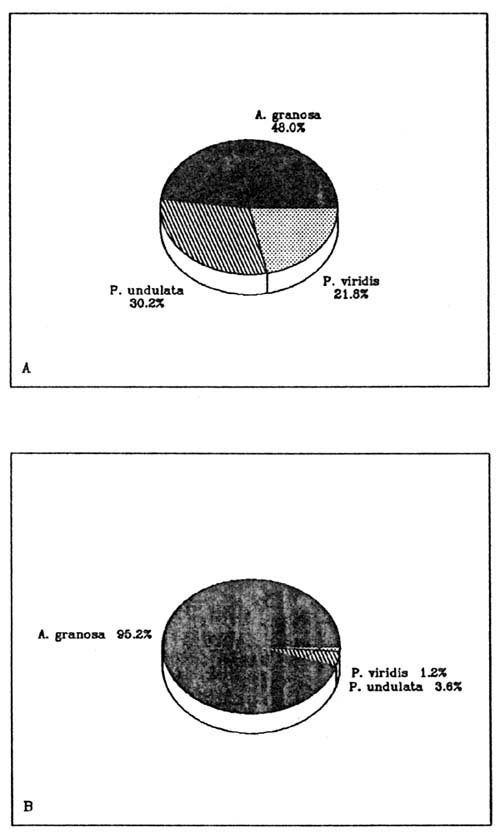Total annual shellfish production output from 1980 to 1986 are shown in Figure 1. Production over this period has gradually decreased from 129,583 MT to 46,740 MT. Table 1 shows the most important bivalve species cultured in Malaysia along with their annual production figures from 1980 to 1986.
Culture of the blood cockle Anadara granosa has been practised in
Malaysia since 1948 in the State of Perak and it has developed
into the most important and organized aquaculture industry in the
country. Its natural distribution is largely limited to the west
coast of Peninsular Malaysia extending from Kedah in the north to
Johore in the south. Although the natural distribution of A.
granosa is mostly confined to the coastal areas of Kedah, Penang,
Perak, Selangor and Johore States, seed have been found along the
east coast especially in sheltered coastal areas in Pahang (Ng,
1984). Mass culture of cockles is being practised by
cooperatives along the west coast of Peninsular Malaysia and in
some lagoons on the east coast. In Sarawak, cockle farming is
practised around the delta of major rivers in the southwest of
the State. There are about 4.000 ha of culture area on the west
coast of the Peninsula and it is reported that about 4.000 people
are involved directly or indirectly in this activity. However,
due to a number of constraints such as overfishing and
environmental deterioration the yearly capture output of this
species has declined since late 1970's. The production in 1980
amounted to 123,862 MT but dropped to only 45,664 MT in 1986,
resulting in an average annual decrease of about 10%.
The carpet clam Paphia undulata is also an important species,
ranked second, with the highest annual production of 3,597 MT in
1982. As with blood cockle, the clam fishery has also shown a
drop in output in the last few years with only 357 MT produced in
1986. Such a decrease may be explain by the fact that the
natural grounds of this bivalve species tend to shift from place
to place, although in some areas their occurrence is more
definite. Generally these clams are collected from the wild and
they are found in abundance only in three States, Perlis, Pulau
Pinang and Selangor.
Culture of the green mussel Perna viridis is practised mainly in
the Strait of Johore and most of the annual production comes from
the natural fisheries. Mussels are ranked second in priority in
shellfish culture development since they are a source of low-cost
protein. The production of mussel increased during the early
1980's with the highest annual production of 3,755 MT in 1982 and
an average growth rate of 37% from 1980. However, probably due
to the relatively poor demand of this seafood, production has
considerably dropped in the last few years with only 709 MT
produced in 1986.
Oyster culture in Malaysia is not well developed with current
production estimated at 10 MT a year (Ng, 1987). Culture
experiments were carried out by Okada in the early 1960's (Okada,
1963). Four species of oysters are found in Malaysia:
Crassostrea belcheri, C. rivularis, Saccostrea cucullata and
Ostrea folium. The first species is the one cultured in the
country, while culture experiments on the other species are being
carried out. C. belcheri is currently being cultured, mostly on
a part-time basis, in the Muar River, Johore. In Kedah culture
of the flat oyster (Q. folium) is being carried out using the
rack and raft culture methods. In Sabah both C. belcheri and S.
cucullata are being cultured using the rack method. Oyster
culture is also practised on a small scale in the State of
Sarawak.
Other bivalve species such as Placuna sp., Geloina sp., Pinna sp
and Modiolus sp. are collected from natural fisheries and sold in
local markets.

Figure 1. Total annual production of commercially important bivalves in Malaysia from 1980 to 1986.

Figure 2. Total production figures for the periods 1981–1983 and 1984–1986 of the major bivalve species in Malaysia.
Table 1: Annual production of commercially important shellfish in Malaysia, 1980–1986. (Values: MT).
| SPECIES | YEAR | ||||||
|---|---|---|---|---|---|---|---|
| 1980 | 1981 | 1982 | 1983 | 1984 | 1985 | 1986 | |
| Anadara granosa | 123,862 | 72,743 | 57,530 | 44,789 | 68,231 | 44,761 | 45,664 |
| Paphia undulata | 3,597 A | 3,597 A | 3,597 | 3,828 | 3,704 | 2,016 | 357 |
| Perna viridis | 2,121 | 2,211 | 3,755 | 2,005 | 629 | 604 | 709 |
| Crassostrea sp. | 3 | 3 | 4 | 2 | 10 | 10 B | 10 B |
A = Production values assumed as constant at year 1982.
B = Production values assumed as constant at year 1984.
Figure 2 shows the production values of the most important bivalve species cultured in Malaysia for the periods 1981 – 1983 and 1984 – 1986. The cumulative output during the second period decreased for all species especially carpet clam and green mussel. The total output of the above two species in the first period amounted to 189,937 MT whereas only 8,019 MT was produced between 1984 and 1986. The production percentages of the three most important bivalve species from the total production for the two periods are shown in Figure 3. The overall total production of both mussel and carpet clam decreased, passing from 21.8% to 1.2% for mussel and from 30.2% to 3.6% for the clam in the period 1981 – 1983 and 1984 – 1986, respectively.
Table 2 summarizes a number of information on the status of bivalve culture in Malaysia. The main constraints affecting oyster culture in Peninsular Malaysia are fouling from other sedentary organisms and algae, predation by xanthid crabs and starfish, siltation and low spatfall. Oyster culture in the Muar River is now affected by poor spatfall which may be due to siltation and poor water quality. The main constraint affecting mussel culture is that mussel has little consumer acceptability. In contrast, the problems that affect the cockle industry are mainly the limited seed supply, site availability and the lack of sanitation measures. A present no sanitation control measures are taken to ensure the wholesomeness of the cockles. There is a growing awareness among the Southeast Asian countries that proper sanitation measures should be instituted to prevent the outbreak of cholera, hepatitis and food poisoning, which have often been linked to the consumption of contaminated cockles.
The Fishery Division of Malaysia is taking steps to promote aquaculture development. Research efforts on biology, culture and identification of potential sites are well underway and it is hoped that the information gathered will assist management planners in the proper management of this important resource. Moreover, studies are underway to develop a bivalve purification system aimed at protecting the health of consumers and making bivalves acceptable in local and overseas markets.

Figure 3. Comparative production percentages of the major bivalve species cultured in Malaysia for the periods 1981–1983 (A) and 1984–1986 (B).
Table 2: Information on status of mollusc culture in Malaysia.
| INFORMATION REQUIRED | SPECIES | |||
|---|---|---|---|---|
| Anadara granosa | Paphia undulata | Crassostrea sp. | Perna viridis | |
| Source of seed | Wild | Wild | Wild | Wild |
| Culture method | Bottom | Bottom | Bottom | Suspended |
| Yield/ha | 40 ton/ha | NA | 18 ton/ha | 315 ton/ha |
| Market | Domestic Export | Domestic Export | Domestic Export | Domestic |
| Production area | 10,000 ha (Natural fishing gruond & aquacul) | 1,000 ha (Natural fishing ground) | 30 ha (Aquaculture) | 100–200 ha |
| Status of culture | Developed | Developing | Developing | Developing |
| Major constraints | - Limited export market - Lack sanitary control | --- | - Limited seed supply - Lack of trained personnel | - Marketability |